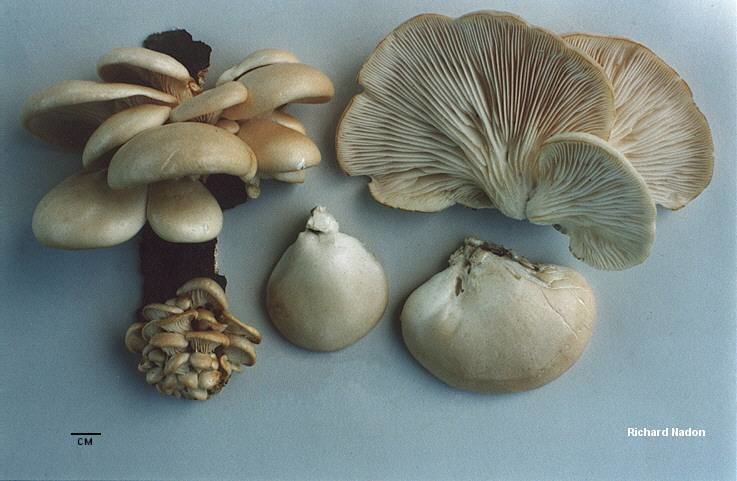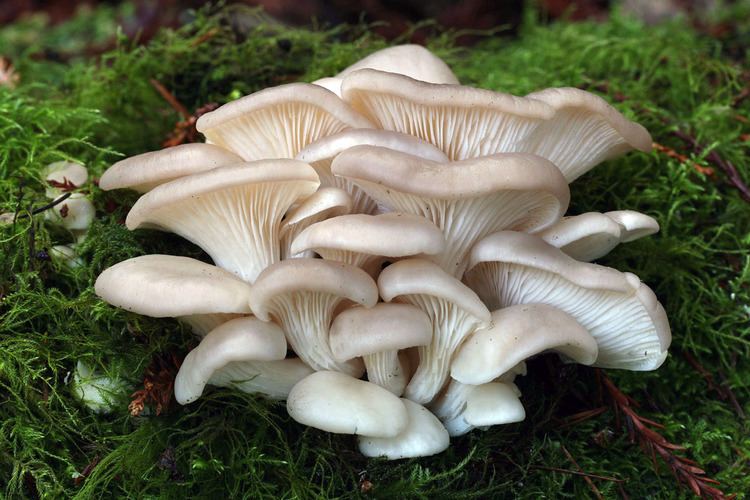Kingdom Fungi Order Agaricales Rank Species | Division Basidiomycota Scientific name Pleurotus ostreatus Higher classification Pleurotus | |
 | ||
Similar Pleurotus, Shiitake, Pleurotus eryngii, Enokitake, Common mushroom | ||
Pleurotus ostreatus fungi kingdom
Pleurotus ostreatus, the oyster mushroom, is a common edible mushroom. It was first cultivated in Germany as a subsistence measure during World War I and is now grown commercially around the world for food. It is related to the similarly cultivated king oyster mushroom. Oyster mushrooms can also be used industrially for mycoremediation purposes.
Contents
- Pleurotus ostreatus fungi kingdom
- Oyster mushroom pleurotus ostreatus identification with adam haritan
- Name
- Description
- Habitat
- Culinary uses
- Non culinary uses
- References
The oyster mushroom is one of the more commonly sought wild mushrooms, though it can also be cultivated on straw and other media. It has the bittersweet aroma of benzaldehyde (which is also characteristic of bitter almonds).

Oyster mushroom pleurotus ostreatus identification with adam haritan
Name

Both the Latin and common names refer to the shape of the fruiting body. The Latin pleurotus (sideways) refers to the sideways growth of the stem with respect to the cap, while the Latin ostreatus (and the English common name, oyster) refers to the shape of the cap which resembles the bivalve of the same name. Many also believe that the name is fitting due to a flavor resemblance to oysters.

The name oyster mushroom is also applied to other Pleurotus species, so P. ostreatus is sometimes referred to as the Tree Oyster Mushroom or the Grey Oyster Mushroom to differentiate it from other species in the genus. Other names may exist:
Description
The mushroom has a broad, fan or oyster-shaped cap spanning 5–25 cm; natural specimens range from white to gray or tan to dark-brown; the margin is inrolled when young, and is smooth and often somewhat lobed or wavy. The flesh is white, firm, and varies in thickness due to stipe arrangement. The gills of the mushroom are white to cream, and descend on the stalk if present. If so, the stipe is off-center with a lateral attachment to wood. The spore print of the mushroom is white to lilac-gray, and best viewed on dark background. The mushroom's stipe is often absent. When present, it is short and thick.
Omphalotus nidiformis is a toxic lookalike found in Australia and Japan. In North America, Omphalotus olivascens, the western jack-o'-lantern mushroom and Clitocybe dealbata, the ivory funnel mushroom, both bear a resemblance to Pleurotus ostreatus. Both Omphalotus olivascens and Clitocybe dealbata contain muscarine and are toxic.
Habitat
The oyster mushroom is widespread in many temperate and subtropical forests throughout the world, although it is absent from the Pacific Northwest of North America, being replaced by P. pulmonarius and P. populinus. It is a saprotroph that acts as a primary decomposer of wood, especially deciduous trees, and beech trees in particular. It is a white-rot wood-decay fungus.
The oyster mushroom is one of the few known carnivorous mushrooms. Its mycelia can kill and digest nematodes, which is believed to be a way in which the mushroom obtains nitrogen.
The standard oyster mushroom can grow in many places, but some other related species, such as the branched oyster mushroom, grow only on trees. They may be found all year round in the UK.
While this mushroom is often seen growing on dying hardwood trees, it only appears to be acting saprophytically, rather than parasitically. As the tree dies of other causes, P. ostreatus grows on the rapidly increasing mass of dead and dying wood. They actually benefit the forest by decomposing the dead wood, returning vital elements and minerals to the ecosystem in a form usable to other plants and organisms. Despite this, the belief that P. ostreatus could damage New Zealand's forestry industry has led New Zealand to ban its importation.
Culinary uses
The oyster mushroom is frequently used in Japanese, Korean and Chinese cookery as a delicacy. It is frequently served on its own, in soups, stuffed, or in stir-fry recipes with soy sauce. Oyster mushrooms are sometimes made into a sauce, used in Asian cooking, which is similar to oyster sauce. The mushroom's taste has been described as mild with a slight odor similar to anise. The oyster mushroom is best when picked young; as the mushroom ages, the flesh becomes tough and the flavor becomes acrid and unpleasant.
Oyster mushrooms are widely cultivated and used in Kerala, India where a wide variety of dishes are prepared from them. Oyster mushrooms are mainly cultivated in large clear polyethylene bags with buns of hay layered in the bags, and spawn sown between the layers.
Oyster mushrooms are also used in the Czech and Slovak contemporary cuisine in soups and stews in a similar fashion to meat.
Oyster mushrooms contain small amounts of arabitol, a sugar alcohol, which may cause gastrointestinal upset in some people.
Non-culinary uses
One manufacturer has proposed using the mycelium along with the growing substrate as a substitute for petroleum derived expanded polystyrene packing material or as an insulating material. Researchers in Mexico have shown that oyster mushrooms can break down disposable diapers.
One preliminary study showed that consumption of oyster mushroom extracts lowered cholesterol levels, an effect linked to their content of beta-glucans.
